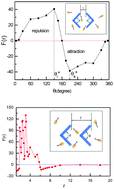An attraction–repulsion transition of force on wedges induced by active particles†
Abstract
Effective forces between two micro-wedges immersed in an active bath are investigated using Brownian dynamics simulations. Two anti-parallel and parallel wedge-like obstacles are considered respectively, and the effective forces between two wedges rely on the wedge-to-wedge distance, the apex angle of the wedge, as well as the particle density and aspect ratio. For two anti-parallel wedges, a transition from repulsion to attraction occurs by varying the apex angle, which is also sensitive to the particle density and aspect ratio. The optimal apex angle θr* (or θa*) and particle density ρ* are characterized by the saturated trapping of active particles inside a wedge. For two parallel wedges, the effective force also experiences a transition from repulsion to attraction as the wedge-to-wedge distance increases. These results originate from the collective trapping effect which is driven by the many-body dynamics of self-propelled particles in the confinement (near the boundary) of obstacles. Our results can provide insight into controlling the motion and assembly of microscopic objects through the suspension of active particles.



 Please wait while we load your content...
Please wait while we load your content...